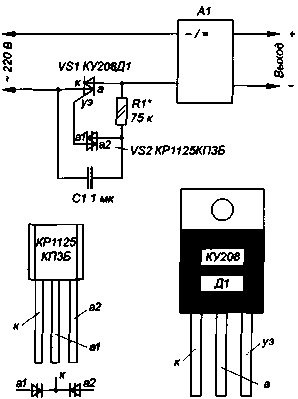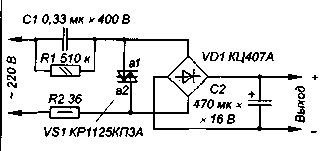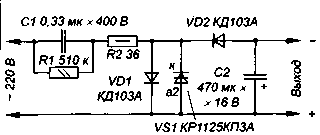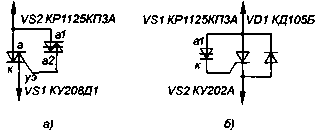
|
|
ENCYCLOPEDIA OF RADIO ELECTRONICS AND ELECTRICAL ENGINEERING Symmetrical dinistors - in power supplies. Encyclopedia of radio electronics and electrical engineering
Encyclopedia of radio electronics and electrical engineering / Power Supplies The main purpose of symmetrical dinistors is to work in triac power controllers. It is interesting to use such a regulator according to a typical scheme for connecting a network adapter designed for a rated voltage of 120V to a 220V network (Fig. 1). When using a triac of the type indicated in the diagram and a metal-film capacitor K73-17 for a rated voltage of 63 V, all elements of the regulator can be installed in the housing of the A1 adapter being finalized. To configure the device, connect the required load and a voltmeter to the adapter output, put a variable 1 kOhm and a constant 220 kOhm, connected in series, instead of the resistor R51. By reducing the resistance of the resistor R1, starting from the maximum value, set the required voltage on the load and replace the selected resistors with one of the closest possible resistance.
In the absence of a triac in a plastic case, you can also use the usual one - KU208V or KU208G. Capacitor C1 must be metal film or paper. The use of ceramic capacitors is undesirable, since the temperature stability of the output voltage will be low. On fig. Figure 2 shows the dependences of the output voltage of the Panasonic KX-A09 adapter (120 V, 60 Hz) supplied with cordless phones KX-TC910-B, load outflow. Curve 1 corresponds to the supply of voltage 105 V with a frequency of 50 Hz to the primary winding, curve 2 - to power supply from the mains 220 V 50 Hz in accordance with the diagram in Fig. 1 and the value of the resistance of the resistor R1, at which the output voltage is 11,8 V, and the load current is 120 mA. This point on curve 1 was chosen to compare different options for including the adapter in [2].
Curve 3 was taken with resistance R1, which provides the nominal adapter output voltage of 12 V and load current of 200 mA. Curve 2 is close to curves 2 and 3 in [2], obtained for connecting the adapter to a 220 V network through a resistor, but the efficiency of the variant of switching through a triac controller is much higher, and the total power dissipated by the adapter is lower. However, the output voltage ripple increased slightly. Interestingly, such voltage reduction devices for powering household appliances - hair dryers, electric shavers, etc. - are produced by foreign manufacturers and sold in Russia. One of them, with which the author had to deal, was called in translation into Russian something like this: "Companion of an American tourist in France." Perhaps the most interesting is the use of a symmetrical dinistor to stabilize the voltage of a transformerless power supply with a quenching capacitor. A diagram of such a device is shown in fig. 3.
It works approximately the same as the block with a zener diode [3], but when the filter capacitor C2 is charged to the turn-on voltage of the dynistor VS1 (to within the voltage drop across the rectifier bridge), it turns on and shunts the input of the diode bridge. The load is powered by capacitor C2. At the beginning of the next half-cycle, C2 is recharged again to the same voltage, the process is repeated. It is easy to see that the initial discharge voltage of capacitor C2 does not depend on the load current and mains voltage, so the stability of the output voltage of the unit is very high. The voltage drop across the dinistor in the on state is small, the power dissipation, and hence the heating, is much less than when installing a zener diode. The calculation of a power supply with a symmetrical dinistor is carried out according to the same formulas as for a source with a zener diode [3], but the minimum current through the stabilizing element Ict min should be set equal to zero, which somewhat reduces the required capacitance of the quenching capacitor. Such a source was experimentally tested with a capacitor C1 with a capacity of 0,315 and 0,64 microfarads (nominal values of 0,33 and 0,68 microfarads) and dinistors KR1125KPZA and KR1125KPZB. The types and ratings of other elements corresponded to those shown in fig. 3. The voltage at the output of the block was about 6,8 and 13,5 V for the KR1125KPZA and KR1125KPZB dinistors, respectively. With a mains voltage of 205 V and a capacitance of the capacitor C1 = 0,315 μF, an increase in the load current from 2 to 16 mA led to a decrease in the output voltage by 70 mV (i.e., by 1%) and by 100 mV for C 1 = 0,64 μF and current change from 4 to 32 mA. A further increase in the load current was accompanied by a sharp drop in the output voltage, and the position of the break point of the load characteristic corresponded with high accuracy to the calculation in accordance with [3]. If it is necessary to connect one of the source outputs to the network wire [4], a half-wave rectifier with a quenching capacitor can be used (Fig. 4).
In this case, to reduce losses, only one of the dinistors of the KR1125KPZ microcircuit is used. Diode VD1 also serves to reduce losses and is not required, since the KR1125KPZ dinistor has a diode to pass current in the opposite direction. The presence or absence of such a diode in the dinistors of the KR1125KP2 series is not reflected in the documentation, and the author failed to purchase such a microcircuit for verification. The maximum direct or pulsating current through the dinistor is determined by the power dissipated by it and is about 60 mA. If this value is not enough to obtain the required output current, you can "amplify" the dinistor with a triac (Fig. 5, a) for use in the source according to the circuit in Fig. 3 or a trinistor (Fig. 5,6) for the device according to the scheme of Fig. four.
The advantages of power supplies with a dinistor are lower power dissipation and greater stability of the output voltage, the disadvantage is a limited choice of output voltages, determined by the turn-on voltages of dinistors. Literature 1. Kuznetsov A. Triac power controller with low noise level. - Radio, 1998, No. 6, p. 60, 61.
Author: S. Alekseev, Moscow; Publication: N. Bolshakov, rf.atnn.ru
Machine for thinning flowers in gardens
02.05.2024 Advanced Infrared Microscope
02.05.2024 Air trap for insects
01.05.2024
▪ Wacom professional graphics tablets ▪ IHLP-6767DZ-11 - High Current Low Profile Inductors ▪ A new iteration of ultra-precise atomic clocks ▪ A new way to control the speed of light
▪ section of the site Factory technology at home. Article selection ▪ Article Better to be a live dog than a dead lion. Popular expression ▪ How old was Uncle Tom? Detailed answer ▪ article Wagonmaker. Standard instruction on labor protection ▪ article The magical journey of the handkerchief. Focus secret
Home page | Library | Articles | Website map | Site Reviews www.diagram.com.ua |






 Arabic
Arabic Bengali
Bengali Chinese
Chinese English
English French
French German
German Hebrew
Hebrew Hindi
Hindi Italian
Italian Japanese
Japanese Korean
Korean Malay
Malay Polish
Polish Portuguese
Portuguese Spanish
Spanish Turkish
Turkish Ukrainian
Ukrainian Vietnamese
Vietnamese





 Leave your comment on this article:
Leave your comment on this article: